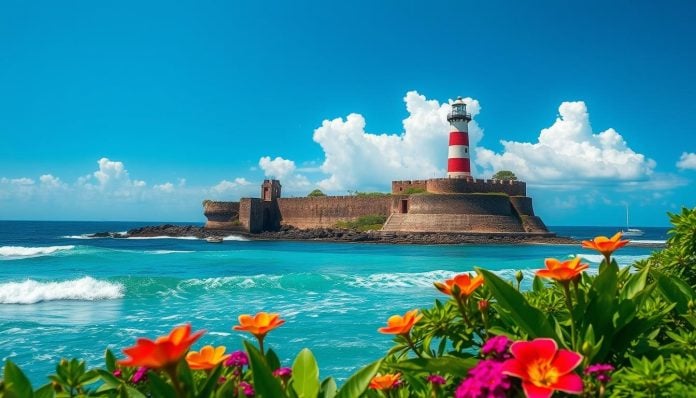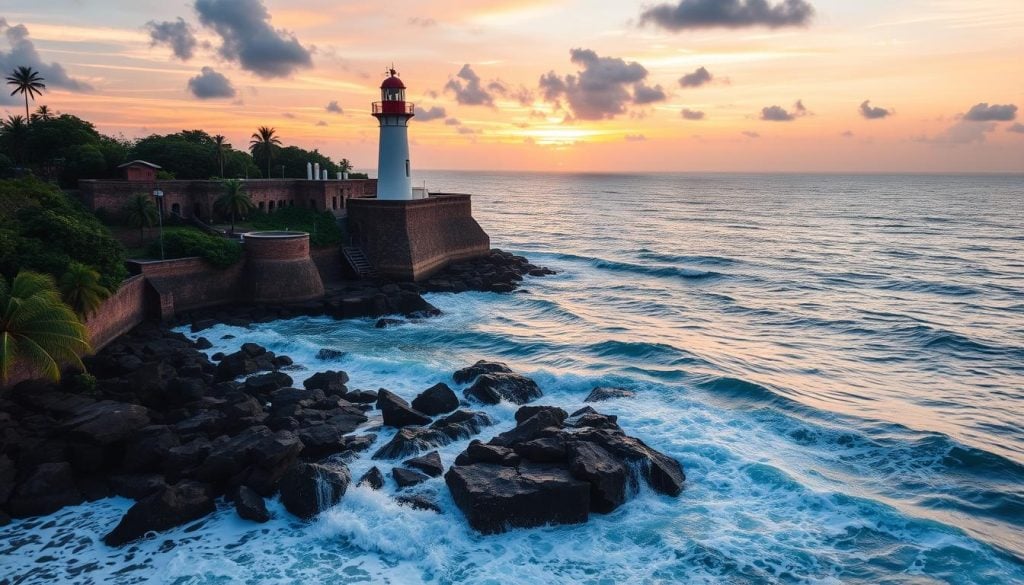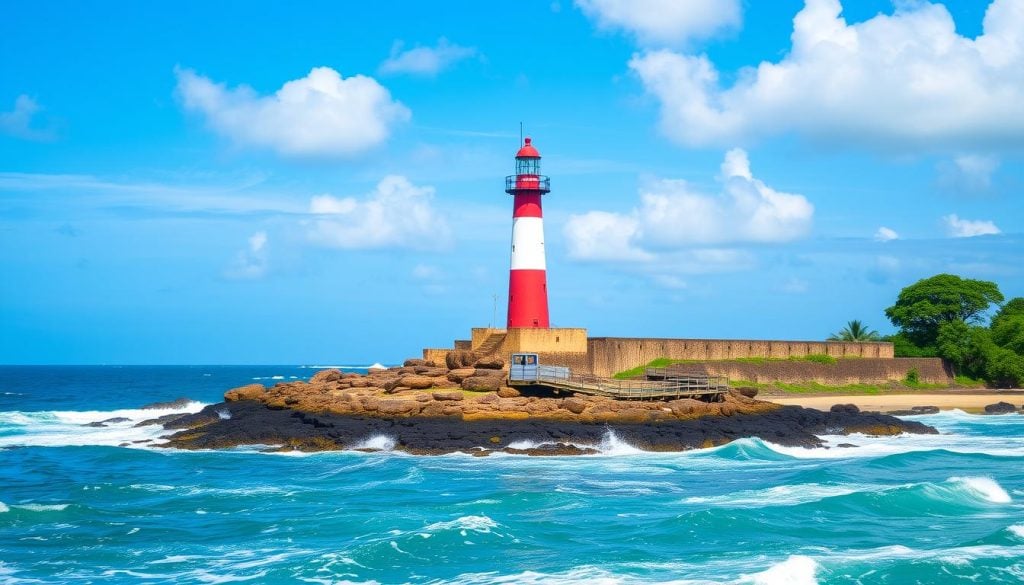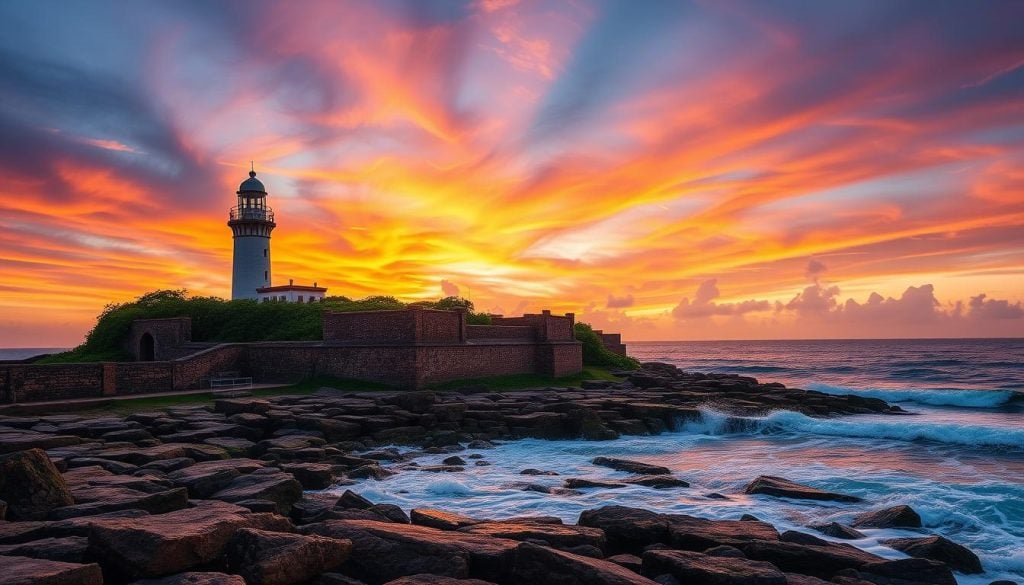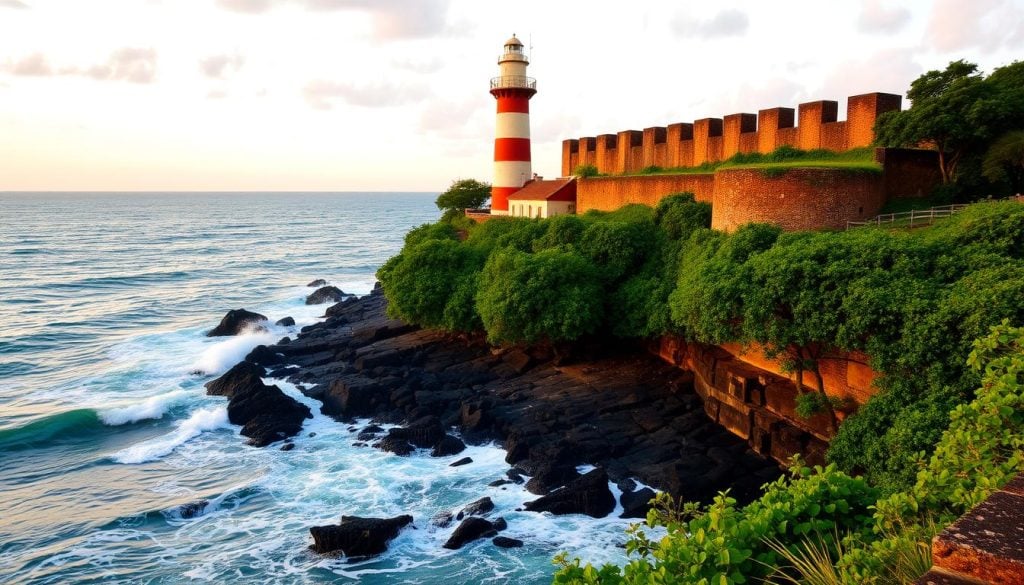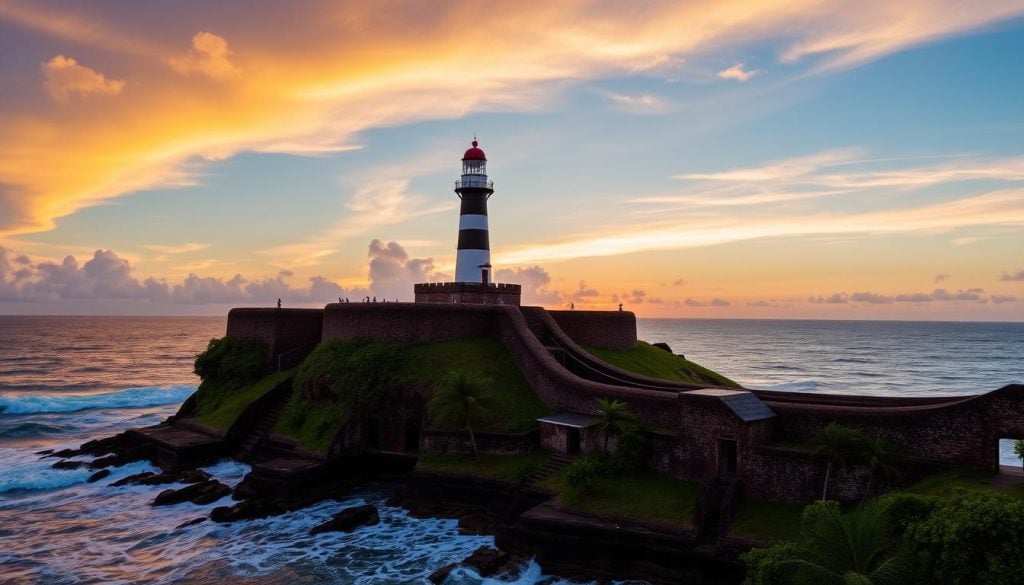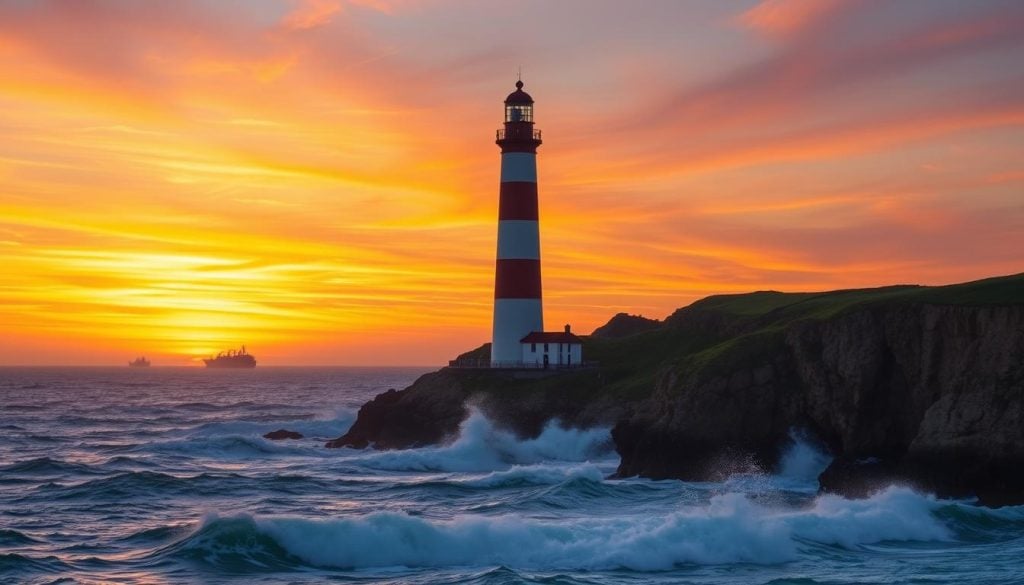Ever wondered why some landmarks are key while others are forgotten? The Galle Fort lighthouse in Sri Lanka is a prime example. It’s a key part of the UNESCO World Heritage Site of Galle Fort. You might be curious, where is the Galle Fort lighthouse, and why is it so important in maritime history?
The Galle Fort lighthouse is at 6°01′28.4″N 80°13′09.7″E. It guides ships into Galle Harbor and tells the story of this coastal gem. We’ll dive into the Galle Fort lighthouse’s location and its historical significance. It’s a top spot for travelers to explore.
Introduction to Galle Fort Lighthouse
The Galle Fort Lighthouse is a landmark that mixes history with beautiful coastal views. It was built in 1848 and is the oldest light station in Sri Lanka. The lighthouse is about 26.5 meters (87 feet) tall, made from strong concrete and stone.
Exploring this site, you’ll see its architectural beauty and its role in guiding ships. The history of the Galle Fort lighthouse shows how navigation tools have changed. It also highlights Galle’s role as a trading port.
Visiting the Galle Fort lighthouse is a chance to learn about the past and see stunning views. You’ll see the Indian Ocean and the old town of Galle. This mix of culture and nature makes your visit unforgettable.
Where is the Galle Fort lighthouse located?
The Galle Fort Lighthouse is a key spot on the southern tip of Galle Fort. It’s placed strategically for both its function and history. Knowing its location adds to your experience when you visit.
Coordinates and Geographic Placement
The Galle Fort lighthouse is at 6°01′28.4″N 80°13′09.7″E. It’s about 20 feet high, making it easy to see from the road. The map shows it’s on a scenic point that goes into the Indian Ocean.
Significance of its Location
The lighthouse’s spot is very important. It helps ships find the harbor safely. It’s also close to historical sites, showing the area’s colonial history. Visiting the lighthouse means seeing many other interesting places too.
Historical Background of Galle Lighthouse
The Galle Fort lighthouse has a rich and intriguing history. It shows the maritime heritage of Sri Lanka. To understand its history, we must look at its origins and the challenges it has faced.
First Construction and Early History
The first Galle lighthouse was built in 1848 by the British. It was designed by Alexander Gordon and stands 24.4 meters tall. Made from cast-iron plates from England, it was painted white.
This lighthouse was a key aid for ships. Its light could be seen for about 12 miles. It helped keep vessels safe as they sailed along the coast.
Reconstruction After Destruction
In 1934, a fire destroyed the original lighthouse. This was a major setback in its history. A new concrete lighthouse was built in 1939, standing at 26.5 meters.
This new lighthouse was built about 100 meters from the old one. It uses modern technology for navigation. The Sri Lanka Ports Authority keeps it running today, keeping its legacy alive.
Architectural Features of Galle Fort Lighthouse
The Galle Fort Lighthouse is a remarkable structure known for its unique architectural features. Its height and design capture the interest of both tourists and locals. This historical site is a must-see for many.
Height and Structure
The Galle Fort lighthouse stands at 26.5 meters tall. This height is crucial for navigation in the tropics. Its sturdy concrete design has a cylindrical shape, making it visible to ships.
The tower’s elevation is impressive. It helps vessels spot the lighthouse from afar. This ensures safety along the Sri Lankan coastline.
Design and Color
The Galle lighthouse’s design is striking, with a white tower and lantern. This color contrasts beautifully with the historic Galle Fort. The lighthouse also has a balcony.
Visitors can enjoy breathtaking views of the sea and fortress walls from here. The design is not just for looks. It also attracts photographers and tourists.
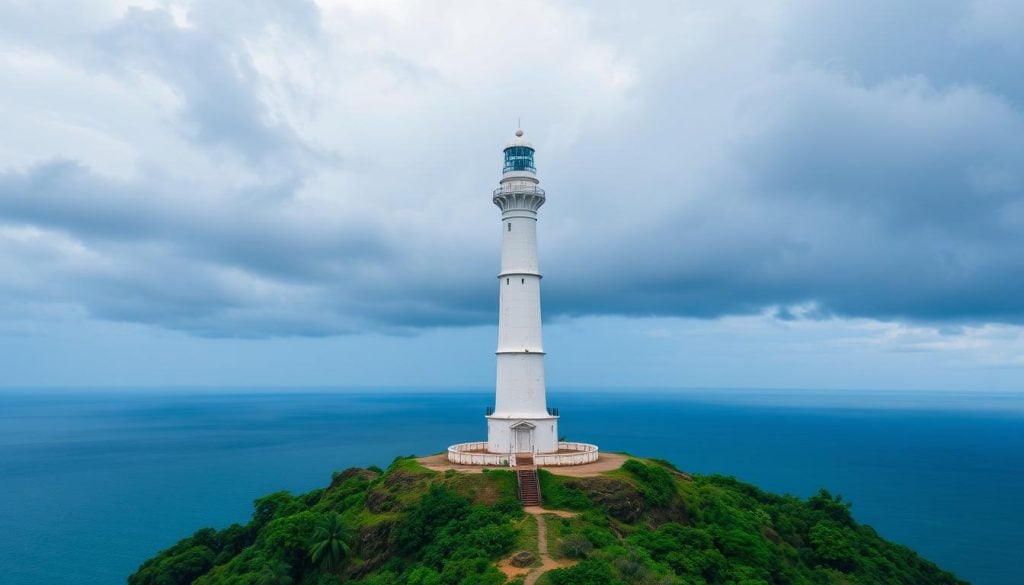
Visiting the Galle Fort Lighthouse
Planning your visit to the Galle Fort lighthouse is exciting. You’ll see amazing views and explore a rich history. The lighthouse, with its beautiful architecture and ocean view, welcomes visitors all year.
For the best photos and a calm atmosphere, visit early mornings or late afternoons. The dry season, from December to March, offers the best weather.
Best Times to Visit
Here are some tips for the best experience:
- Early morning: Marvel at sunrise and the soft, warm light.
- Late afternoon: Enjoy stunning sunsets and cooler temperatures.
- Dry season (December – March): Ideal weather for outdoor activities.
Nearby Attractions
The area around the Galle Fort lighthouse is full of interesting places. While there, check out these attractions:
- Ancient churches that display impressive architectural beauty.
- Engaging museums that showcase local history and culture.
- Vibrant markets that offer unique local crafts and foods.
- Scenic ramparts perfect for leisurely walks with ocean views.
- The maritime museum, adding depth to your understanding of the area’s history.
Accessing Galle Fort Lighthouse
Planning your visit to Galle Fort Lighthouse is easy with the right info. The trip lets you see beautiful views and dive into Galle’s culture.
Directions to Galle Fort Lighthouse
Start in Colombo to find Galle Fort Lighthouse. Drive south on the Southern Expressway. It’s about 126 kilometers, taking 2 to 2.5 hours.
When you get to Galle, look for signs to Galle Fort. They’ll guide you to the lighthouse.
Best Way to Reach Galle Fort Lighthouse
Driving or taking a taxi is best to get to the lighthouse. It gives you freedom and lets you enjoy the scenic drive.
For a cheaper option, take a bus from Colombo or other cities. Once in Galle, walking through the historic Fort gets you to the lighthouse.
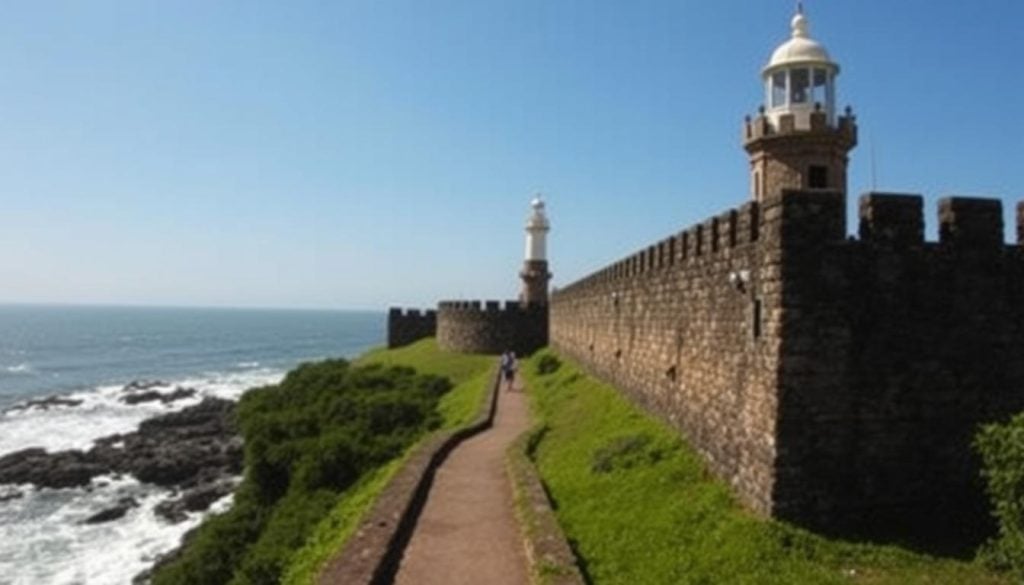
Galle Fort as a UNESCO World Heritage Site
Exploring the Galle Fort UNESCO site gives you a peek into Sri Lanka’s rich history. This site, a UNESCO World Heritage Site since 1988, has well-preserved fortifications. It shows a mix of European and South Asian architectural styles.
But Galle Fort is more than its beauty. It shows the lasting impact of colonialism and the need to protect Sri Lanka’s maritime heritage.
Significance of Galle Fort
The Galle Fort is important for its history and architecture. It was a key spot for colonial powers, showing Galle’s role in maritime trade. Walking its cobblestone streets, you see walls and bastions that tell stories of defense and change.
Combining Visits: Lighthouse and Fort
Visiting the Galle Lighthouse is even better with a trip to the Galle Fort nearby. These two landmarks are close, offering a deep look at their importance. The lighthouse helps with navigation, while the Fort’s history is vast.
Together, they tell a story of the site’s past. It’s a journey through history and culture.
Galle Lighthouse’s Role in Maritime Navigation
The Galle Lighthouse has been a key part of maritime history since 1848. It guides ships through the complex waters of Galle Harbor. This lighthouse is crucial for maritime trade and exploration in Sri Lanka’s southwest.
Historical Navigation Importance
The Galle lighthouse has safely guided many ships into port. It was built to meet the growing maritime needs of the area. This lighthouse marked the harbor’s edge and showed the region’s dedication to safe navigation.
Modern Technological Features
Today, the Galle Fort lighthouse uses advanced technology. It has a computer-controlled system for its light operations. This change shows how maritime technology has evolved, keeping the lighthouse reliable and true to its past.
| Feature | Historical System | Modern System |
|---|---|---|
| Operation | Manual by keepers | Automated computer control |
| Light Source | Lantern with oil | LED technology |
| Signal Frequency | Fixed signals | Variable and adaptive |
| Maintenance | Regular manual checks | Remote monitoring |
Thanks to these updates, the lighthouse keeps its historical value while meeting today’s navigation needs. It ensures safety for ships in Galle Harbor’s busy waters.
Local Culture and Activities around Galle Lighthouse
The area around Galle Lighthouse is full of life and culture. As you walk through the streets, you’ll see street vendors, food stalls, and kids playing cricket. These scenes show the daily life in Sri Lanka, making your visit real and engaging.
Street Life and Local Events
Exploring around Galle Lighthouse, you’ll find many local events and festivals. Markets with crafts, food, and performances give you a taste of Galle Fort’s culture. Joining in these events lets you connect with the community and see the heart of its traditions.
Cultural Significance of the Lighthouse
The Galle Fort Lighthouse is more than a guide for sailors. It symbolizes Galle’s maritime history and colonial past. Visitors come to learn about this history. By experiencing both the history and the lively activities, you’ll appreciate Galle’s unique culture more.

































